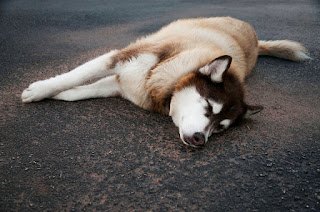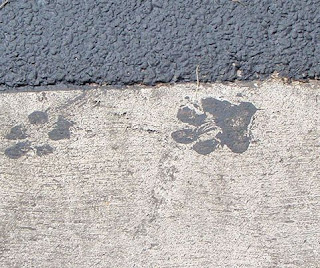
On Paws and PAHs
(polycyclic aromatic hydrocarbons)
Recently we faced the unpleasant decision to put a dog of ours, Chandler (above left) to sleep after being a big part of the family for nearly 13 years. Even though she was annoying at times with family and guests, I am surprised by the sadness I feel at the loss.
While the saying is true that they teach us about love, life and loss, I think many of us would want to put off that loss as far into the future as possible. Many must share this sentiment because CBS News reports that we are spending close to $60 Billion per year on our pets’ health care. With their longevity in mind, let me share what I have learned about coal tar and pets.
 |
| Photo by Garen Meguerian |
This is the first story on this blog about pets and the effects of coal tar pavement sealers. Over the years I’ve heard stories from pet owners concerned about a change in their pet’s health which coincided with a sealer job. I figured that if people knew about its potential affects on their own health and those of their children, then it wouldn’t be necessary to talk about animals. Let’s see.
Clinical Definition
Did you know that “coal tar poisoning” is a known condition of animals? Since running this site I have heard some negative reports on the effects that coal tar sealer can have on pets.
Yes the Merck Manual, Pet Health Edition details the causes which is typically ingestion of some kind of coal tar product. The manual states “coal tar–related poisoning has been reported in farm animals and pets.”
Lest you think this is some of temporary risk, poisoning has been reported decades after the material entered the environment.
Tar on Paws
Here’s an example of a dog which got coal tar on its paws:
Customer Question
My dog got his feet into some black tar and now his paws stuck together. He has been eating the tar and now seems lethargic. what should I do?

Expert: Dr.Fiona replied.
Hi again,
Tar contains phenols which are POISONOUS to dogs!!
It is really important that you get this off him and prevent him from eating any more. To get it off, you can first rub vegetable oil into it, then wash with liquid dish detergent (Dawn if you have it). Repeat several times until you get this tar off him!
Coal tar toxicity can occur even just from absorbing the product through the skin, but certainly can be a problem if the dog has been licking and chewing at it. This can be really serious, even fatal! If the dog has licked or swallowed any of this, it can cause chemical burns in his mouth and esophagus mucosa (surface). Also, phenols can cause damage to the nervous system, kidneys, liver, blood, and heart.
So, because of the potential for corrosive burns DO NOT make your dog vomit. It can cause a lot more harm to bring it back up, because the esophagus is more at risk for a corrosive burn than the stomach. Do not give activated charcoal because charcoal in mucosal wounds may impair healing.
Right now I would like you to give your dog a mix of 50:50 water and milk – 1/2 cup NOW and then 2 tablespoons every 15 minutes.
You need to get your dog to the vet ASAP to get some sucralfate which is a stomach protector. This can be given in pill or milkshake form and will help to protect the stomach and intestines. Take along this phone number: animal poison control centre (888)(NNN) NNN-NNNN/strong>. A $60 consultation fee may be applied to your credit card. Your vet may need to call if he or she hasn’t dealt with this before.
When you get the dog to the vet, he will do a complete oral exam looking for burns. However, pain, inflammation, redness and swelling may not be visible for 2-4 hours after the tar was eaten. The full extent of the injury won’t be known for 12 hours after exposure as the corrosive burns take that long to show up.
Treatment of burns in the mucosa should include antibiotics, pain medication as needed, gastrointestinal protectants (e.g. sucralfate), anti-inflammatories (corticosteroid use is controversial) and general supportive care.
In cases with severe oral burns or esophageal burns, your veterinarian may have to place a feeding tube into the dog’s stomach so that food and water can be given to him through this tube while the mucosa heals. This can take weeks. There is a risk of a stricture or narrowing forming in the esophagus.
So, in summary, this may be a fairly minor incident if you are only talking about a bit of tar the size of a penny. Or it could be fairly serious if it was bigger. You should know in the next 12 hours. Please continue the milk mixture and get your dog to your vet promptly. Call them to let them know you are coming so they can get ready.
If this has been helpful, please hit the green “Accept” button, and leave feedback. I will still be here to provide more information if you need it.
The above is given for information only. Although I am a licensed veterinarian, I cannot legally prescribe medicines or diagnose your pet’s condition without performing a physical exam. If you have concerns about your pet I would strongly advise contacting your regular veterinarian.
Good luck, and please let me know what happens!
Fiona
Animal effects of coal tar poisoning have also been found with pigs who bedded on straw which had initially been laid on top of freshly laid coal tar paving and then removed and used for bedding. It appears that about 1 in 10 pigs died and the subsequent investigation found liver discoloration and abnormalities. Another veterinarian source comes from situations where the pens holding piglets was impregnated with coal tar.
| Coal tar exposed liver |
| Healthy pig liver |

